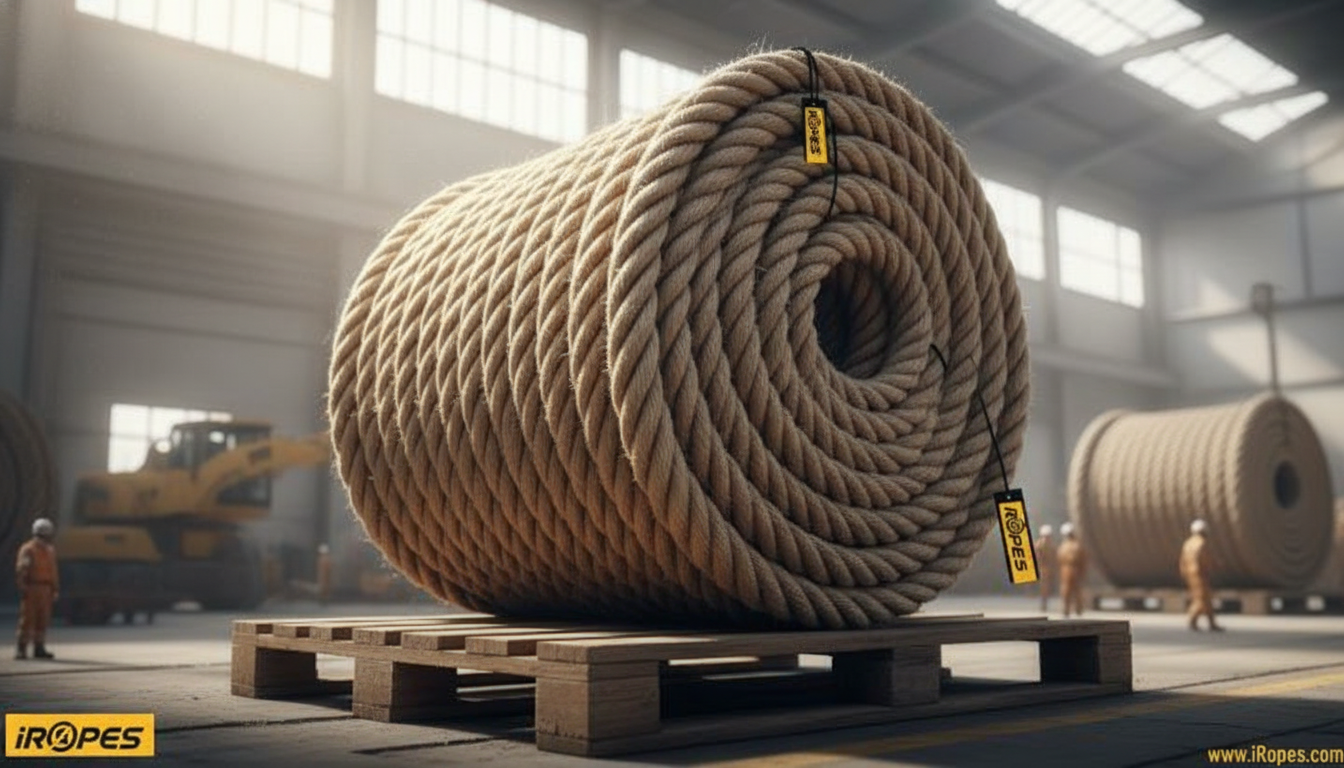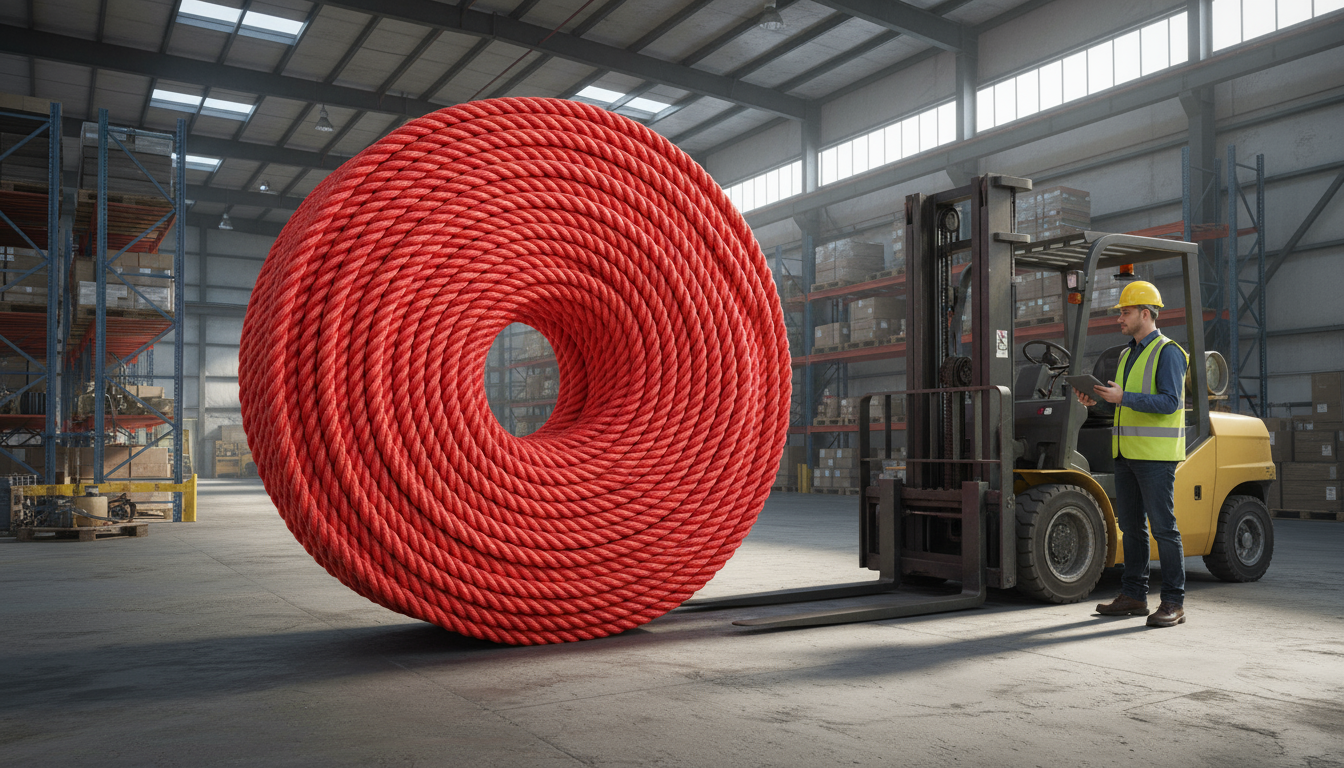iRopes can ship custom large‑diameter rope up to 3 in, with high‑tensile double‑braid options and fast lead times for customised orders. ✅
What you’ll gain – 2 min read
- ✓ Help reduce project downtime with ropes made under an ISO 9001‑certified quality system.
- ✓ Choose material (hemp, nylon, braided) and construction to maximise strength for your application.
- ✓ Get branding on rope or packaging to reinforce your corporate image.
- ✓ Forecast costs early – price bands from $0.40 to $14.00 per ft depending on diameter and construction.
You’ve probably been told that the biggest rope on the shelf automatically wins the load‑bearing race. In reality, material and construction rule the game. For example, a 1‑inch large braided rope (double‑braid nylon core) often achieves a 6 000–8 000 lb working load limit, while a 1‑inch large hemp rope typically sits around 1 800–2 000 lb. With iRopes, you can customise large hemp rope, large nylon rope, or large braided rope to suit mining, lifting, and other industrial jobs—saving time, budget, and maintenance.
Large Hemp Rope
After highlighting why rope diameter can make or break a heavy‑duty project, let’s dive into the natural alternative that many engineers reach for when UV exposure and minimal stretch are non‑negotiable.

Why hemp works so well
- UV resistance – the plant fibres resist sun damage better than many synthetics, so colour fading and strength loss remain modest with proper care outdoors.
- Low stretch – elongation stays around 1–2 % at full load, giving predictable behaviour for static‑load rigs.
- Typical applications – static lines, handrails and barriers, decorative landscaping, and mooring where a natural look is required.
Performance metrics you’ll need
When you move from a ½‑inch sample to a truly large‑diameter rope, the numbers shift dramatically. Below is a quick rundown of what a large hemp rope can deliver.
- Tensile strength baseline ≈ 350–400 lb per inch of diameter (estimate only; actual values depend on construction—always confirm with test data).
- Working Load Limit (WLL) = Tensile ÷ 5 (Cordage Institute guideline); a 1‑inch hemp rope typically supports roughly 1 800–2 000 lb WLL.
- Diameter range for “large” sizes: ½ in to 3 in, custom‑spooled to suit bulk orders.
So, is hemp rope stronger than nylon? The short answer is no—at 1‑inch, nylon typically delivers a 4 000–5 500 lb WLL versus 1 800–2 000 lb for hemp. However, hemp’s low stretch and solid UV stability give it an edge in static‑load environments where precise length and sun exposure are concerns. In other words, choose hemp when you need a rope that holds its length and look under relentless sun, and pick nylon when sheer pull‑capacity and shock absorption are the priority.
“Our off‑road operators keep coming back for large hemp rope because the material holds up in the desert sun, and the low‑stretch behaviour reduces the need for frequent re‑tensioning.” – Lead rope engineer, iRopes.
With the strengths and limits of hemp clarified, the next material we’ll explore brings high elasticity to the table—perfect for scenarios where a little give can absorb shock without breaking.
Large Nylon Rope
After exploring hemp’s low‑stretch stability, you’ll notice that many heavy‑duty projects actually rely on a material that can absorb shock without snapping. That material is large nylon rope, a synthetic option prized for its elasticity and wear resistance.

Key Characteristics
Large nylon rope delivers a high degree of elasticity, typically stretching 4–6 % under full load, and it resists abrasion from sharp edges or rough surfaces. Industries such as mining hoists, offshore rigging, and heavy‑equipment recovery regularly specify this rope for its ability to dampen sudden jolts while maintaining load‑bearing capacity.
However, the same elasticity that cushions impact also creates challenges when precise positioning is required. Nylon’s polymer structure readily absorbs water; a wet rope can lose up to 15 % of its strength. The material also stretches noticeably under sustained loads, which may demand extra tensioning in static‑load rigs. Finally, prolonged exposure to ultraviolet light can degrade the fibres unless a UV‑blocking coating is applied.
Disadvantages of nylon rope include water absorption that reduces strength, higher stretch under load, and gradual UV degradation without protective treatment.
So, if you’re weighing the trade‑offs, ask yourself whether your application can tolerate a few percent of stretch and occasional moisture exposure. When you need a rope that yields just enough to absorb a shock wave—think of a mining hoist that must survive sudden load spikes—large nylon rope often proves the most reliable choice.
Next, we’ll compare these properties with the strongest construction option available for ultra‑heavy lifting: large braided rope.
Large Braided Rope
After seeing how nylon’s elasticity can both help and hinder a lift, the next question is which architecture extracts the maximum load‑bearing potential. Braided ropes achieve that by intertwining multiple strands into a cohesive sheath, and the way those strands are arranged determines the final strength.

The construction style is the biggest driver of performance. A double‑braid wraps two protective layers around a core, delivering the highest load capacity. A solid‑braid interweaves every strand in a single layer, offering a slimmer profile with strong load‑bearing ability. Diamond‑braid crosses strands in a diamond pattern, balancing flexibility and strength—useful when some give is required during dynamic lifts.
Construction Types
How the braid is built
Double‑Braid
Two layers of yarn wrap a core, giving the highest load capacity and redundancy.
Solid‑Braid
All strands are interwoven in one layer, offering strong performance with a slimmer profile.
Diamond‑Braid
Strands cross in a diamond pattern, balancing flexibility and strength for dynamic loads.
Strength Impact
What the construction means
Peak
Double‑braid typically delivers the highest tensile ratings and WLL for a given diameter.
Balanced
Solid‑braid provides strong all‑round performance for many static lifts.
Flex
Diamond‑braid adds flexibility when controlled give is desirable in dynamic systems.
Which rope is strongest for heavy lifting? In practice, a large braided rope—specifically a double‑braid with a nylon core—outperforms both large hemp rope and plain large nylon rope at like‑for‑like diameters. For 1‑inch ropes, braided options often reach a 6 000–8 000 lb WLL, versus 4 000–5 500 lb for standard nylon and around 1 800–2 000 lb for hemp.
Understanding these construction nuances lets you match the rope to the job, whether you’re pulling a mining haul‑line or securing a marine dock. The next step is to see how iRopes turns these engineered options into custom, market‑ready solutions.
Custom large‑diameter rope solutions
Having seen how a double‑braid can outperform other builds, you may wonder how that capability becomes a reality for your own project. iRopes bridges the gap between raw material performance and a rope that arrives ready for the job site, with every detail tuned to your specifications.

Our OEM/ODM service starts with a material‑selection matrix that lines up the three core families—large hemp rope, large nylon rope and large braided rope—against the key performance traits you care about. From there we move to core construction: parallel‑core for ultimate static strength, fibre‑core when you need a softer bend, or a hybrid core that balances rigidity and flexibility. Finally, we let you brand the rope itself or the packaging, so the product arrives with your logo, colour scheme or even a unique pattern that distinguishes it on the job site.
Materials
Choose hemp for UV stability, nylon for high elasticity, or a double‑braid construction when maximum load capacity is non‑negotiable.
Cores
Select a parallel‑core for the stiffest line, a fibre‑core for easy handling, or a hybrid core that blends strength with flexibility.
Branding
Custom colourways, logo embossing on the sheath, or printed labels on the packaging turn a standard rope into a branded asset.
Packaging
Options range from bulk pallets and sealed cartons to eco‑friendly reusable bags, with non‑branded or customer‑branded presentations—tracked under ISO 9001 procedures and shipped worldwide.
Quality Assurance
ISO 9001 certification, full IP protection and a multi‑stage testing regime help ensure every large‑diameter rope meets the strict standards demanded by mining, lifting and offshore applications. See our Certification page for details.
Pricing follows clear bands that let you forecast costs early in the project. For a 1‑inch diameter, a large hemp rope starts around $0.90 per foot, a large nylon rope at $1.10 per foot, and a large braided rope between $1.60 and $2.30 per foot. Scale‑up to a 3‑inch line pushes the range to $5–$8 (hemp), $6.5–$10 (nylon) and $9–$14 (braided). Lead times depend on the finish you choose and order size; standard orders are scheduled promptly, and rush batches with colour or logo customisation are available.
If you’re ready to translate those numbers into a rope that bears your brand and your load, simply contact iRopes for a free quote from our ISO 9001‑certified team. The next part of the guide will show how those customised ropes perform once they’re in the field.
Need a personalised large‑diameter rope solution?
From the UV‑stable strength of large hemp rope to the shock‑absorbing stretch of large nylon rope and the superior load capacity of large braided rope, the guide has shown how each material meets specific heavy‑duty demands. iRopes leverages its ISO‑9001 facilities, OEM/ODM expertise and IP protection to turn these engineered options into tailor‑made, big‑diameter solutions for mining, lifting and other industrial applications – a service that has consistently earned client praise.
If you’d like a custom specification that aligns with your branding, load requirements and delivery timeline, simply fill out the form above and our specialists will provide a personalised quote and technical advice.